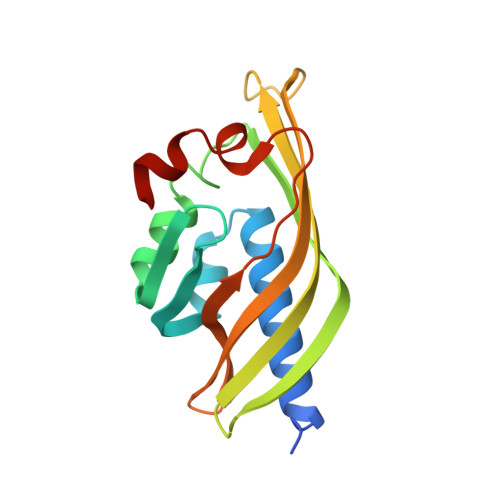Cryogenic X-ray crystal structure analysis for the complex of scytalone dehydratase of a rice blast fungus and its tight-binding inhibitor, carpropamid: the structural basis of tight-binding inhibition.
Nakasako, M., Motoyama, T., Kurahashi, Y., Yamaguchi, I.(1998) Biochemistry 37: 9931-9939
- PubMed: 9665698
- DOI: https://doi.org/10.1021/bi980321b
- Primary Citation of Related Structures:
2STD - PubMed Abstract:
Scytalone dehydratase is a member of the group of enzymes involved in fungal melanin biosynthesis in a phytopathogenic fungus, Pyricularia oryzae, which causes rice blast disease. Carpropamid [(1RS,3SR)-2, 2-dichloro-N-[(R)-1-(4-chlorophenyl)ethyl]-1-ethyl-3-methylcyclopropa necarboxamide] is a tight-binding inhibitor of the enzyme. To clarify the structural basis for tight-binding inhibition, the crystal structure of the enzyme complexed with carpropamid was analyzed using diffraction data collected at 100 K. The structural model was refined to a crystallographic R-factor of 0.180 against reflections up to a resolution of 2.1 A. Carpropamid was bound in a hydrophobic cavity of the enzyme. Three types of interactions appeared to contribute to the binding. (i) A hydrogen bond was formed between a chloride atom in the dichloromethylethylcyclopropane ring of carpropamid and Asn-131 of the enzyme. (ii) The (chlorophenyl)ethyl group of carpropamid built strong contacts with Val-75, and this group further formed a cluster of aromatic rings together with four aromatic residues in the enzyme (Tyr-50, Phe-53, Phe-158, and Phe-162). (iii) Two hydration water molecules bound to the carboxamide group of carpropamid, and they were further hydrogen-bonded to Tyr-30, Tyr-50, His-85, and His-110. As a result of interactions between carpropamid and the phenylalanine residues (Phe-158 and Phe-162) in the C-terminal region of the enzyme, the C-terminal region completely covered the inhibitor, ensuring its localization in the cavity.
- The Institute of Physical and Chemical Research (RIKEN), Saitama, Japan.
Organizational Affiliation:


















